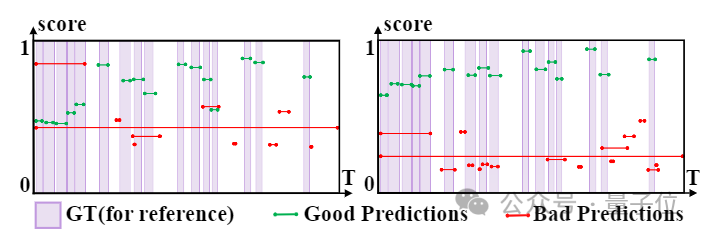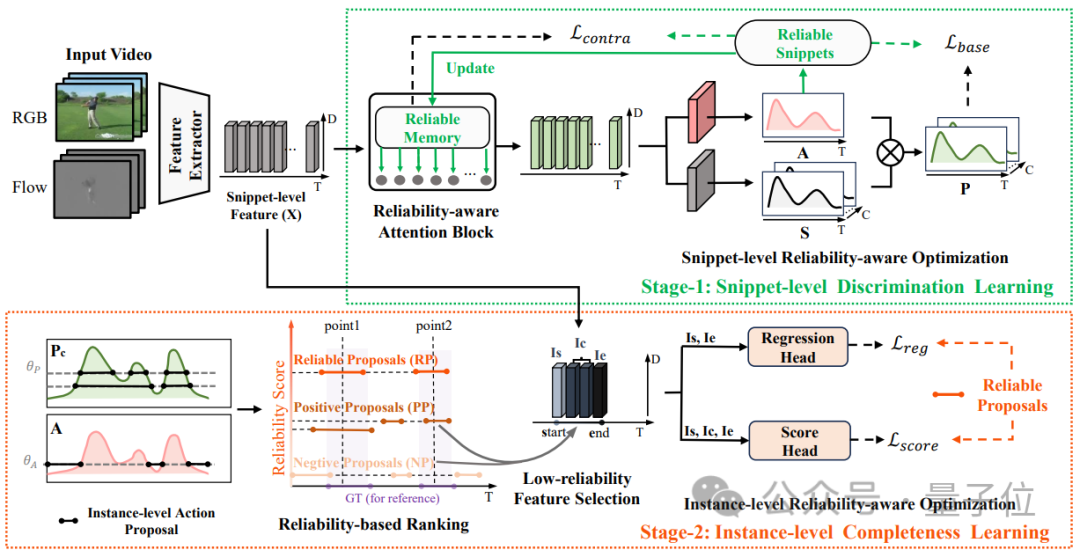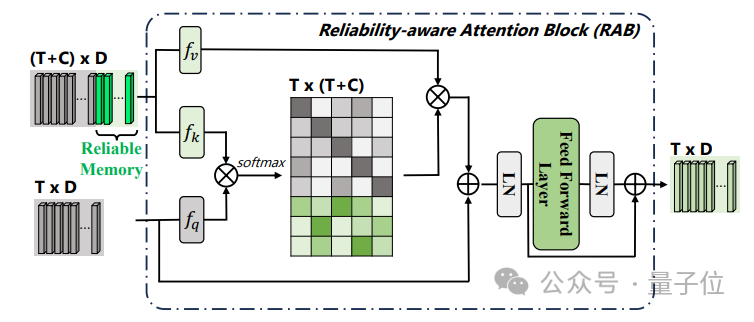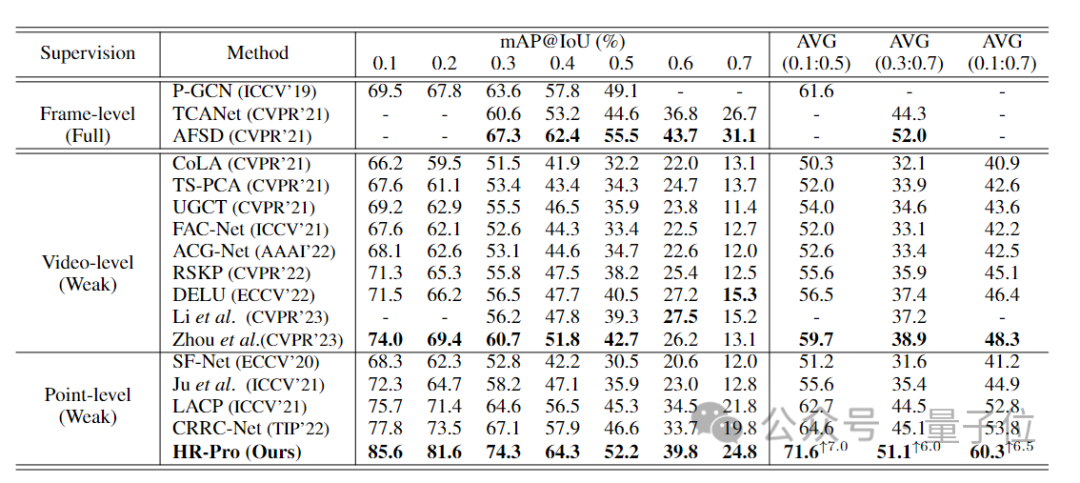 Technology peripherals
Technology peripherals
 AI
AI
 Segment features can be learned by labeling a single frame of video, achieving fully supervised performance! Huake wins new SOTA for sequential behavior detection
Segment features can be learned by labeling a single frame of video, achieving fully supervised performance! Huake wins new SOTA for sequential behavior detection
Segment features can be learned by labeling a single frame of video, achieving fully supervised performance! Huake wins new SOTA for sequential behavior detection
How to find interesting clips from a video? Temporal Action Localization (TAL) is a common method.
After using video content for modeling, you can freely search within the entire video. The joint team of Huazhong University of Science and Technology and the University of Michigan has recently brought new progress to this technology-In the past, modeling in TAL was at the fragment or even instance level; Now only one frame ofin the video can achieve , and the effect is comparable to that of full supervision.

- For the "golf swing" behavior, HR-Pro effectively distinguishes between behavior and context Segments, alleviating LACP's intractable False Positive predictions;
- For the discus throwing behavior, HR-Pro detects more complete segments than LACP, which has lower activation values on non-discriminative action segments .

(The left side is the result before instance-level integrity learning, and the right side is the result after learning. The horizontal and vertical axes represent time and reliability scores respectively.)

fragment-level discriminative learningandinstance-level complete Sexual learning.

Phase 1: Segment-level discriminative learning
The research team introduces reliability-aware segment-level discriminative learning, proposes to store reliable prototypes for each category, and uses them within the video to and video-to-video methods to propagate high-confidence cues from these prototypes to other clips.
Fragment-level reliable prototype construction
In order to build reliable prototypes at the fragment level, the team created an online updated prototype memory to store reliable prototypes of various behaviors mc (where c = 1, 2, …, C) in order to be able to utilize the feature information of the entire data set.
The research team chose to initialize the prototype with point-labeled segment features:

Next, the researchers used pseudo-labeled behavioral segment features to update each Category prototypes are specifically expressed as follows:

Fragment-level reliability awareness optimization
In order to combine the feature information of fragment-level reliable prototypes Passed to other fragments, the research team designed a Reliabilty-aware Attention Block (RAB) to inject reliable information from the prototype into other fragments through cross-attention, thereby enhancing the robustness of fragment features and Increased focus on less discriminative segments.

In order to learn more discriminative fragment features, the team also constructed a reliability-aware fragment comparison loss:

Phase 2: Instance-level integrity learning
In order to fully explore the temporal structure of instance-level behaviors and optimize the proposed score ranking, the team introduced instance-level action integrity learning.
This approach aims to refine the confidence scores and bounds of proposals through instance-level feature learning, guided by reliable instance prototypes.
Instance-level reliable prototype construction
In order to utilize the instance-level prior information of point annotation during the training process, the team proposed a proposal generation method based on point annotation Used to generate proposals with different Reliabilities.
According to their reliability scores and relative point annotated timing positions, these proposals can be divided into two types:
- ##Reliable Proposals (Reliable Proposals, RP ): For each point in each category, the proposal contains this point and has the highest reliability;
- Positive Proposals (Positive Proposals, PP): All the rest Candidate Proposal.
Instance-level reliability-aware optimization
To predict the completeness score of each proposal, the research team inputs the proposal features of sensitive boundaries into the score prediction head φs:




# In short, HR-Pro can achieve great results with only a few annotations. It reduces the cost of obtaining tags and at the same time has strong generalization capabilities, providing favorable conditions for actual deployment applications.
According to this, the author predicts that HR-Pro will have broad application prospects in behavioral analysis, human-computer interaction, driving analysis and other fields.
Paper address: https://arxiv.org/abs/2308.12608
The above is the detailed content of Segment features can be learned by labeling a single frame of video, achieving fully supervised performance! Huake wins new SOTA for sequential behavior detection. For more information, please follow other related articles on the PHP Chinese website!

Hot AI Tools

Undresser.AI Undress
AI-powered app for creating realistic nude photos

AI Clothes Remover
Online AI tool for removing clothes from photos.

Undress AI Tool
Undress images for free

Clothoff.io
AI clothes remover

AI Hentai Generator
Generate AI Hentai for free.

Hot Article

Hot Tools

Notepad++7.3.1
Easy-to-use and free code editor

SublimeText3 Chinese version
Chinese version, very easy to use

Zend Studio 13.0.1
Powerful PHP integrated development environment

Dreamweaver CS6
Visual web development tools

SublimeText3 Mac version
God-level code editing software (SublimeText3)

Hot Topics
 1386
1386
 52
52
 Centos shutdown command line
Apr 14, 2025 pm 09:12 PM
Centos shutdown command line
Apr 14, 2025 pm 09:12 PM
The CentOS shutdown command is shutdown, and the syntax is shutdown [Options] Time [Information]. Options include: -h Stop the system immediately; -P Turn off the power after shutdown; -r restart; -t Waiting time. Times can be specified as immediate (now), minutes ( minutes), or a specific time (hh:mm). Added information can be displayed in system messages.
 Detailed explanation of docker principle
Apr 14, 2025 pm 11:57 PM
Detailed explanation of docker principle
Apr 14, 2025 pm 11:57 PM
Docker uses Linux kernel features to provide an efficient and isolated application running environment. Its working principle is as follows: 1. The mirror is used as a read-only template, which contains everything you need to run the application; 2. The Union File System (UnionFS) stacks multiple file systems, only storing the differences, saving space and speeding up; 3. The daemon manages the mirrors and containers, and the client uses them for interaction; 4. Namespaces and cgroups implement container isolation and resource limitations; 5. Multiple network modes support container interconnection. Only by understanding these core concepts can you better utilize Docker.
 How to define header files for vscode
Apr 15, 2025 pm 09:09 PM
How to define header files for vscode
Apr 15, 2025 pm 09:09 PM
How to define header files using Visual Studio Code? Create a header file and declare symbols in the header file using the .h or .hpp suffix name (such as classes, functions, variables) Compile the program using the #include directive to include the header file in the source file. The header file will be included and the declared symbols are available.
 Do you use c in visual studio code
Apr 15, 2025 pm 08:03 PM
Do you use c in visual studio code
Apr 15, 2025 pm 08:03 PM
Writing C in VS Code is not only feasible, but also efficient and elegant. The key is to install the excellent C/C extension, which provides functions such as code completion, syntax highlighting, and debugging. VS Code's debugging capabilities help you quickly locate bugs, while printf output is an old-fashioned but effective debugging method. In addition, when dynamic memory allocation, the return value should be checked and memory freed to prevent memory leaks, and debugging these issues is convenient in VS Code. Although VS Code cannot directly help with performance optimization, it provides a good development environment for easy analysis of code performance. Good programming habits, readability and maintainability are also crucial. Anyway, VS Code is
 Docker uses yaml
Apr 15, 2025 am 07:21 AM
Docker uses yaml
Apr 15, 2025 am 07:21 AM
YAML is used to configure containers, images, and services for Docker. To configure: For containers, specify the name, image, port, and environment variables in docker-compose.yml. For images, basic images, build commands, and default commands are provided in Dockerfile. For services, set the name, mirror, port, volume, and environment variables in docker-compose.service.yml.
 What underlying technologies does Docker use?
Apr 15, 2025 am 07:09 AM
What underlying technologies does Docker use?
Apr 15, 2025 am 07:09 AM
Docker uses container engines, mirror formats, storage drivers, network models, container orchestration tools, operating system virtualization, and container registry to support its containerization capabilities, providing lightweight, portable and automated application deployment and management.
 What platform Docker uses to manage public images
Apr 15, 2025 am 07:06 AM
What platform Docker uses to manage public images
Apr 15, 2025 am 07:06 AM
The Docker image hosting platform is used to manage and store Docker images, making it easy for developers and users to access and use prebuilt software environments. Common platforms include: Docker Hub: officially maintained by Docker and has a huge mirror library. GitHub Container Registry: Integrates the GitHub ecosystem. Google Container Registry: Hosted by Google Cloud Platform. Amazon Elastic Container Registry: Hosted by AWS. Quay.io: By Red Hat
 What is the docker startup command
Apr 15, 2025 am 06:42 AM
What is the docker startup command
Apr 15, 2025 am 06:42 AM
The command to start the container of Docker is "docker start <Container name or ID>". This command specifies the name or ID of the container to be started and starts the container that is in a stopped state.





